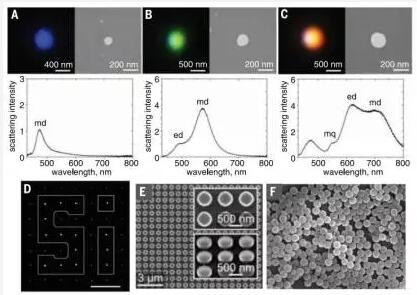Abstract 1. Accumulation of charged defects controls domain wall conduction in ferroelectric BiFeO3 (Domain-wallconductioninferroelectricBiFeO3controlledbyaccumu...
1. Accumulation of charged defects controls domain wall conduction in ferroelectric BiFeO3
(Domain-wall conduction in ferroelectric BiFeO3 controlled by accumulation of charged defects)
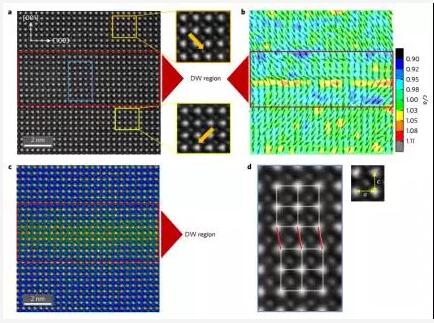
The accumulation of moving charge defects in the domain wall region to shield the polarization charge is used as a source of conductivity for the domain wall regions in the ferroelectric material. Despite a lot of work in theory and experimentation, this idea has not yet been directly confirmed, leaving a gap in understanding the wonderful electrical properties in the domain wall region. Tadej Rojac et al. provided atomic-scale chemical and structural analyses demonstrating the accumulation of charged defects in domain wall regions in BiFeO3. Defects of the BiFeO3 species are identified as Fe4+ cations and vacancies, and p-type hopping at the domain walls is caused by electron holes associated with Fe4+. Consistent with the p-type characteristics, Tadej Rojac et al. further demonstrate that local domain wall conductivity can be adjusted by controlling the gas pressure during high temperature annealing. This work is important for the design of localized conductivity of domain-based devices and ferroelectric materials. (Nature Materials DOI: 10.1038/NMAT4799)
2. Using SnO2 to enhance electron extraction in high efficiency planar solar cells
(Enhanced electron extraction using SnO2 for high-eciency planar-structure HC(NH2)2PbI3-based perovskite solar cells)
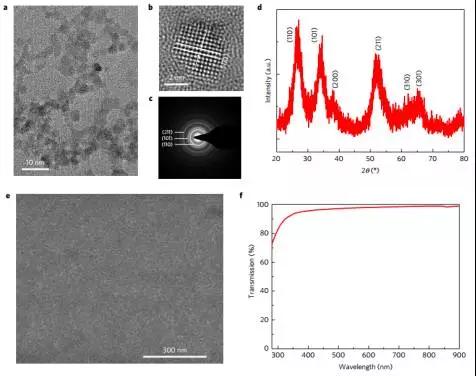
Recently, planar structure halide perovskite solar cells have attracted attention due to their simple and low temperature device fabrication process. Unfortunately, planar structures typically exhibit IV hysteresis and lower stable device efficiency compared to mesoporous structures, especially TiO2-based nip devices. Compared with conventional TiO2, SnO2 has a deeper conduction band and higher electron mobility, which can enhance charge transfer from perovskite to electron transport layer and reduce charge accumulation at the interface. Jingbi You et al. proposed a low temperature solution treatment of SnO2 nanoparticles as a highly efficient electron transport layer for perovskite solar cells. This SnO2-based device enhances electron extraction with virtually no hysteresis. They obtained an efficiency of 19.9 ± 0.6% by introducing a PbI2 passivation phase into the perovskite layer. The device can be easily processed at low temperatures (150 ° C), which provides an efficient method for large-scale production of perovskite solar cells. (Nature Energy DOI: 10.1038/NENERGY.2016.177)
3. Host-guest chemistry of water-soluble gold nanoparticle superspheres
(Host–guest chemistry with water-soluble gold nanoparticle supraspheres)
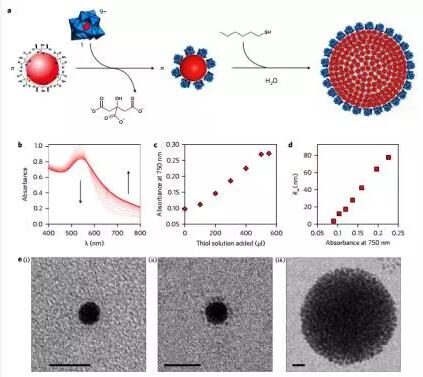
The uptake of molecular objects as a hallmark of supramolecular chemistry of shells and containers has not been documented for the soluble assembly of metal nanoparticles. Yizhan Wang et al. demonstrated that gold nanoparticles-based hyperspheres can serve as hosts for hydrophobic uptake, transport, and subsequent release of more than two million guest species, which are five orders of magnitude greater than the mass per unit volume and comparable to metal-organic framework compounds. . The superspheres were prepared by adding hexyl mercaptan to the polyoxometalate protected 4 nm gold nanoparticles in water. This supersphere contains 200 nm hydrophobic cavities between every 27,400 gold structural units, connected to each other by nano-sized pores. This produces a percolation network that can efficiently absorb large amounts of molecules from water, and the large number of molecules absorbed includes 600,000, 2,100,000 and 2.6 million molecules (35,190 and 234 g·l-1) of p-dichlorobenzene, bisphenol A and trinitrobenzene, respectively. Toluene. (Nature Nanotechnology DOI: 10.1038/NNANO.2016.233)
4. A flat organic-inorganic hybrid ink in a colloidal quantum dot solid
(Hybrid organic–inorganic inks flatten the energy landscape in colloidal quantum dot solids)

The energy band tail state in the disordered semiconductor material results in a loss of open circuit voltage (Voc) and inhibits carrier transport in the photovoltaic process. For colloidal quantum dot (CQD) films that promise low-cost, large-area, air-stable photovoltaic conversion, the band tail is determined by the polydispersity and uneven aggregation of CQD synthesis during ligand exchange. Liu et al. introduced a new synthesis method for liquid phase ligand exchange CQD inks, which can achieve a flat energy band and a beneficial high bulk density. These materials exhibit sharper band tails and reduced energy pooling in the solid state compared to the best CQD films previously used for photovoltaics. Therefore, when a solar cell has a higher VOC and a more efficient charge injection into the electron acceptor, it is possible to absorb more light with a near optimal band gap. These enable the manufacture of CQD solar cells by liquid phase ligand exchange and ensure a power conversion efficiency of 11.28%. The device is stable in the unpackaged state after being stored in the air for more than 1,000 hours. (Nature Materials DOI: 10.1038/NMAT4800)
5. Mixing the normal, superconducting and topological states of double quantum dots
(Normal, superconducting and topological regimes of hybrid double quantum dots)
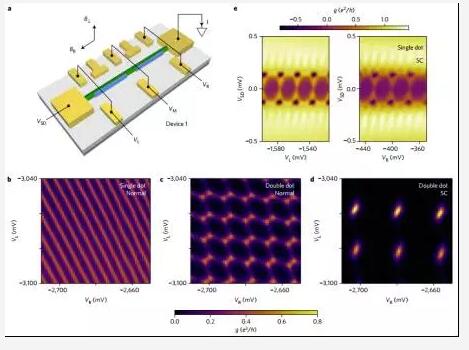
Because semiconductors inherit a hard superconducting energy gap while maintaining tunable carrier density, epitaxial semiconductor-superconductor hybrid materials are a good basis for studying mesoscopic and topological superconductivity. D. Sherman et al. explored a two-quantum dot structure formed by InAs nanowires and patterned epitaxially grown double-sided shell-like aluminum with aluminum along the nanowires near the two gate regions. They studied the system-mediated superconductivity and charging energy as a function of the magnetic field and voltage tuning barrier function. The side gates are used to achieve a strong to weak change in the inter-point coupling, and the ground state is varied between normal, superconducting, and topological states by applying a magnetic field. D. Sherman et al. identified topological transitions by tracking the spacing between successive common tunneling peaks as a function of axial magnetic fields, and demonstrated that individual quantum dots dominate the weakly mixed Majorana mode. (Nature Nanotechnology DOI: 10.1038/NNANO.2016.227)
6. Optical Resonant Dielectric Nanostructures
(Optically resonant dielectric nanostructures)
The driving force for rapid progress in nanophotonics comes from the development of optically resonant nanostructures, which enhance the near-field effect of far-field scattering through inter-mode interference enhancement. Most such near-field effects are often associated with plasmonic nanostructures. Recently, a new branch of nanophotonics has emerged in an attempt to manipulate strong, light-induced electrical and magnetic Mie resonances in high refractive index dielectric nanoparticles. In the design of optical nano-antennas and metamaterial surfaces, dielectric nanoparticles provide an opportunity to reduce dissipation losses and achieve large resonance enhancement of electric and magnetic fields. Arseniy I. Kuznetsov et al. reviewed this rapidly evolving field and clarified that the magnetic response of dielectric nanostructures can lead to new physical effects and applications. (Science DOI: 10.1126/science.aag2472)
7. Structure of typical TiO2 photocatalytic interface
(Structure of a model TiO2 photocatalytic interface)
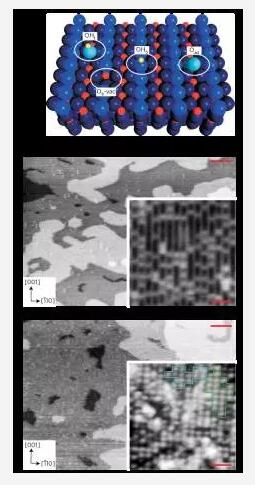
The interaction of water with TiO2 is critical for many practical applications, including photocatalytic water cleavage. Since the first demonstration of this phenomenon 40 years ago, researchers have done a lot of research on the interface of rutile single crystal TiO2 (110) with water. This provides an atomic understanding of the water-titanium dioxide interaction. However, almost all research on the water/TiO2 interface involves water in the gas phase. H. Hussain et al. explored the interfacial structure of liquid water and rutile TiO2 (110) at the atomic scale. Scanning tunneling microscopy and surface X-ray diffraction confirmed that the structure consisted of an ordered array of hydroxyl molecules with molecular water in the second layer. Static and dynamic density functional theory calculations show that the mechanism of forming the hydroxyl capping layer may involve the mixed adsorption of O2 and H2O on the surface of some defects. The quantitative structural properties obtained here provide the basis for exploring atomic properties and TiO2 photocatalytic mechanisms. (Nature Materials DOI: 10.1038/NMAT4793)
8. Ferroelectric thin film materials and their applications
(Thin-film ferroelectric materials and their applications)
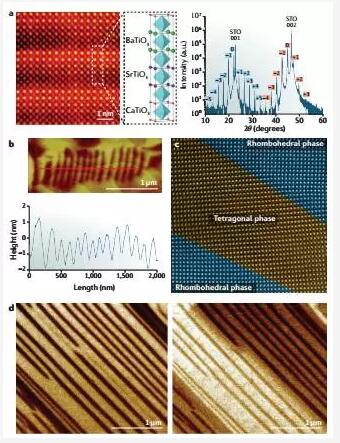
Ferroelectric materials have been widely used in many fields due to spontaneous polarization. Recent advances in simulation, synthesis and characterization techniques have contributed to the unprecedented development of such materials. Martin and Rappe reviewed recent advances in thin film ferroelectric materials and discussed the possibility of controlling their properties through strain regulation using both traditional and unconventional methods. They also explored how research on ferroelectric materials extends our understanding of some fundamental effects, making possible discoveries of novel and physical phenomena and better controlling material properties. They also discussed the many possibilities for developing new devices including devices in electrical, thermal and photovoltaic applications. Finally, they gave a short survey of the development of the field in the coming years. (Nature Review Materials DOI:10.1038/natrevmats.2016.87)
This article is authorized by the new material online (micro signal: xincailiaozaixian), if other media need to reprint, please contact the new material online small series (micro signal)
Essential Oil is a part of life and have been used for centuries for both their healing and aromatic benefits. It is a concentrated, volatile, aromatic liquid that is obtained from the fruits, seeds, flowers, bark, stems, roots, leaves or other parts of a plant. Essential oils can be used for a wide range of emotional and physical wellness applications.
They can be used as single essential oils or in complex essential oil blends depending on user experience and desired benefit. There are estimated to be 8,000 aromatic plants that contain essential oils on Earth, and about 500 of these are processed commercially for essential oil extraction. Every essential oil carries its own unique benefits.
Sandalwood oil can benefits for its ability to encourage mental clarity and relaxation; Geranium oil is commonly used as an element in aromatherapy for its many health benefits; Jasmine oil, is a popular natural remedy for improving mood and overcoming stress. citronella oil most commonly used as a natural fragrant oil, in insect repellents, as well as in beauty.
According to scientific research, pure citronella oil is known to have amazing antibacterial and antifungal abilities. Tea Tree Essential Oil is one of the best essential oils for acne as well as for healing the skin; Patchouli oil has strong scent that has been used for centuries in perfumes; more recently it`s been used in Incense, insect repellents . Valerain oil can benefit for relieving smooth muscle and dilating coronary arteries to improve blood flow to the heart. Michelia flower oil is good floral fragrance which can be applied with a variety of formula of high-grade daily-using flavors.
Essential Oil
Pure Essential Oils,Essential Oil,Natural Essential Oil,Healthy Essential Oil
Xinhui Gangzhou Flavors&Fragrance Co.,Ltd , https://www.xhgzff.com





